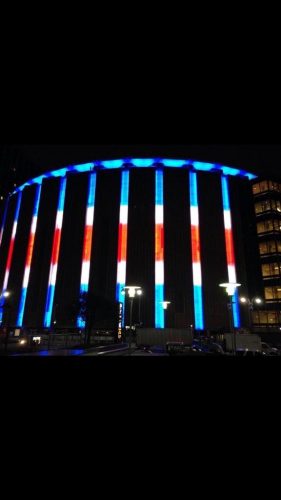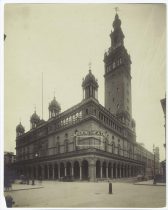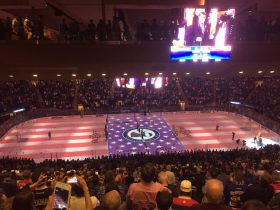Madison Square Garden

Madison Square Garden
Before the current day Madison Square Garden, which was completed in 1968, there was actually three Madison Square Garden’s that were open to attract the people of New York and around the world to enjoy various sports, concerts and other forms of entertainment. The original Madison Square Garden was originally constructed and was open for business starting in 1871 in Manhattan. In 1890 the second Madison Square Garden opened on the same site as the original. Once again, Madison Square Garden was not open for long when a new Garden was built, now the third different Madison Square Garden within 60 years, opening in 1925. Lastly, the current day Madison Square Garden opened in 1968. All of the Madison Square Garden’s had a big impact on the culture of New York City, even though that they were not all on the same site.
The first Madison Square Garden’s construction plan started in 1871, as P.T. Barnum leased the area that was owned by Cornelius Vanderbilt and converted it into “Barnum’s Hippodrome.” [1] P.T. Barnum’s use for Madison Square Garden was to display his circus including his elephant purchased from a zoo in London, named “Jumbo”. When Barnum’s lease expired Vanderbilt renamed the venue Madison Square Garden. Madison Square Garden I was located at 26thStreet and Madison Avenue. On Memorial Day in 1879, Madison Square Garden opened as an arena for activities such as boxing matches and Barnum’s circus acts. Madison Square Garden I also had a cycling track inside the venue becoming one of the few places in the United States that had that inside a venue. Cycling in Madison Square Garden was strictly for races. The first Madison Square Garden had no roof to it, therefore it was deemed ineffective because of all of the inclement weather. Madison Square Garden I really wasn’t made popular by any particular events as mentioned before it was mainly used for cycling, which at the time it was biggest and most popular sport. Vanderbilt eventually sold Madison Square Garden I it to JP Morgan, with then having the intent to knock it down and build a stadium with a roof. JP Morgan successfully completed the purchase and redesigned a new Madison Square Garden that was enclosed and opened in 1890.

Madison Square Garden II opened in 1890, the construction cost a little more than 500 thousand dollars. The arena was enclosed unlike the first one, and it was one of the tallest buildings in New York at the time.[2] It was also known for its iconic 32 story tower that was modeled after the bell tower of the Cathedral of Seville. On top of the 32 story tower was a statue of Diana, who was the Goddess of hunt and moon. The main sports were more of the same as the original Madison Square Garden with cycling being the most popular. Other events that took place at Madison Square Garden II were operas and the 1924 National Democratic convention. Even though Madison Square Garden II was considered a cultural standout in New York it didn’t make much of a profit which caused the demolition and rebuilding of the third Madison Square Garden in 1925, where Madison Square Garden really took off.
The third Madison Square Garden, completed in 1925, took under a year to build. It cost an outstanding 4.75 million dollars to build, the project was backed by millionaires including Tex Rickard, who was the face of ownership. The building was designed to hold a large crowd of over 18 thousand people and had a square design. Madison Square Garden III was the first Madison Square Garden that was not located near Madison Square Park, It was located on Eighth Avenue between 49th and 50th Streets in Manhattan. This new Madison Square Garden quickly became a staple of New York City and became increasingly popular around the world. People from all over would flock to Madison Square Garden for sports and entertainment, like the prior ones but this Garden became extremely popular fast.
The first event to take place at Madison Square Garden III was a cycling race but that wasn’t one of the most popular attractions at Madison Square Garden III. The emergence of the New York Rangers Hockey Club drew thousands of fans for games and it quickly became one of the most popular events that would take place at Madison Square Garden III. Basketball was also a growing sport and Madison Square Garden III quickly became the heart of basketball holding several NCAA finals and also hosting the first ever televised basketball game. New York got a professional team, that being the New York Knicks of the National Basketball Association, who were founded in 1946, that drew thousands of people, the people of New York were also into boxing, boxing was so popular that in 1941 there was an attendance of over 23 thousand people, five thousand more people than the intended max capacity crowd to this day that is the largest crowd ever recorded throughout all of the Madison Square Gardens.[3] The people of New York City were infatuated with the circus, it was so popular that the New York Rangers had to play a Stanley Cup Finals game on the road because the circus was in town. Other historical events also took place at this site. In 1937 there was a rally to boycott Nazi Germany held by the American Jewish Congress, the rally drew a near max capacity crowd. Contrary to the boycott of Nazi Germany, just two years later a pro-Nazi gathering was held and it drew 20 thousand people.[4] Perhaps the most notable event that happened at Madison Square Garden III was in May of 1962, where Marilyn Monroe sang Happy Birthday to then President John F Kennedy. The iconic building was eventually closed in 1968 with the opening of the modern day Madison Square Garden that was constructed on a different sight. The building was officially demolished after the new Madison Square Garden was open for business in 1968.
The modern Madison Square Garden’s construction was completed in 1968 and it opened between 31st and 33rd Street from Seventh to Eighth Avenue. Its first event was a “Salute the USO” event which had celebrities such as Bing Crosby perform. The cost to get a seat at the grand opening were anywhere from $10-$250.[5] Madison Square Garden quickly became one of the most recognizable buildings in New York City, not because of its height or size, but because of the abnormal round shape and the iconic round ceiling that left the people enamored. The present day Garden has the ability to hold a little over 20,000 people during boxing matches and concerts, and just under 20,000 for Basketball and Hockey. Another unique feature in the modern day Madison Square Garden is that it included a theater that was underneath the main level where the sporting events and concerts took place, which also opened in 1968. Another rare and unique feature of Madison Square Garden is that when the building opened in 1968 so did the launching of the Madison Square Garden Network. The network was the first ever regional sports network and show New York Rangers, New York Knicks and NCAA events.
Much like the previous Garden’s people came to Madison Square Garden for sports and entertainment. The New York Rangers of the National Hockey League and the New York Knicks of the National Basketball Association were the original teams to call the new Garden home with the St John’s Red Storm basketball team joining them the following year in 1969. People also flocked to Madison Square Garden for boxing, with the most iconic fight taking place between Muhammed Ali and Joe Frazier known as “The Fight of the century” in 1971, which resulted in Joe Frazier defeating Muhammad Ali with over 20 thousand people in attendance. The fight was so thrilling that a fan actually died of a heart attack. [6] Other iconic moments that took place at the current day Madison Square Garden was Elvis’ sellout performance in 1972, which was an album that he recorded at Madison Square Garden and released it. John Lennon’s last ever concert before getting assassinated took place in April of 1975, he performed in front of a sellout crowd, The post September 11th concert held in October of 2001 was a monumental day in Madison Square Garden history, the concert was held to raise money for the people that lost loved ones in the attacks and also to honor the brave men and women that died in the tragic event. It was also a place where people began to attempt to heal and the tremendous amount of super star musicians and other celebrities came out in support, including Paul McCartney.
One of the main reasons that Madison Square Garden is widely recognized as the world’s most famous arena is because of its location, in the middle of Manhattan. Madison Square Garden was also constructed on top of Pennsylvania Station, with service from the Long Island Rail Road and the emergence of New Jersey Transit , it made Madison Square Garden that much accessible to people in the tri-state area.

Madison Square Garden went over massive renovations in 2011 and it was completed in late 2013, the renovations cost owner James Dolan nearly a billion dollars. The renovations were a major overhaul, including a redesign in the seating arrangement, a brand new scoreboard, and a bridge inside the arena.[7]
Madison Square Garden became a staple for sports and entertainment starting in the late 1800s until the present day. The Garden expanded from just an arena to a having its own television network that broadcasts the local professionals sports teams to the New York Metropolitan area and the arena combined with the network is considered to be worth around 4.5 billion dollars. The venue is considered one of the most popular arenas in the world with Madison Square Garden calling itself “The World’s Most Famous Arena”. It is considered “The World’s Most Famous Arena” because of its rich history of events that took place at all four Madison Square Garden’s. Madison Square Garden forever changed New York City because of the large historical impact that Madison Square Garden has made. It draws native New Yorker’s and also tourists all throughout the world come to Madison Square Garden, not just for entertainment but for the sheer history of the building, which is now the oldest sports venue in New York City. From the late nineteenth century until today the people of New York City craved sports and entertainment and Madison Square Garden supplied the people with world class sports and entertainment, creating one of the biggest cultural impacts in New York City history.
[1] Lois Weiss. “Madison Square Garden’s Many Incarnations — and Locations.” New York Post. N.p., 2013.
[2] Charles Rivers Editors. “Madison Square Garden:The History of New York City’s Most Famous Arena” 2015 (17-25)
[3]Joseph Durso. “Madison Square Garden 100 Years of History” 1978. (pg 72)
[4] “U.S. Political Events Throughout The History of MSG.” U.S. Political Events Throughout The History of MSG. Accessed November 17, 2016. http://www.thegarden.com/articles/political-events.html.
[5] Nathan Kanter. “New Madison Square Garden Opens in 1968.” NY Daily News. 1968
[6] Dave Anderson “Joe Frazier Beats Muhammad Ali In Fight of The Century” March 9th 1971.
[7] “MSG Unveils Final Phase of $1B Renovation.” Newsday. 2013.
Annotated Bibliography
[1] Lois Weiss. “Madison Square Garden’s Many Incarnations — and Locations.” New York Post. N.p., 2013.
Lois Weiss writes about the different Madison Square Garden’s including the purchase and leasing of the first Madison Square Garden. Weiss’ talks about how P.T. Barnum who used it as primarily a place to show off his circus and didn’t renew his lease with the Vanderbilt’s after it was up.
[2] Charles Rivers Editors. “Madison Square Garden:The History of New York City’s Most Famous Arena” 2015 (17-25)
This book focuses on the construction aspect of Madison Square Garden and went into detail how Madison Square Garden II had a very unique statue atop it’s 32 story tower.
[3]Joseph Durso. “Madison Square Garden 100 Years of History” 1978. (pg 72)
In this book, Joseph Durso focuses in on the specific events that took place at all 4 Madison Square Garden’s. Writing about the specifics such as the largest crowd in Madison Square Garden History.
[4] “U.S. Political Events Throughout The History of MSG.” U.S. Political Events Throughout The History of MSG. Accessed November 17, 2016. http://www.thegarden.com/articles/political-events.html.
This site is a timeline of all the political events that took place at Madison Square Garden.
[5] Nathan Kanter. “New Madison Square Garden Opens in 1968.” NY Daily News. 1968
In this Primary source, Kanter writes about what took place at the grand opening of Madison Square Garden. He goes into specific detail on who performed and how much a seat costs. He also mentions the celebrities that were there performing and those of whom were in attendance.
[6] Dave Anderson “Joe Frazier Beats Muhammad Ali In Fight of The Century” March 9th 1971.
In this primary source, Dave Anderson was a witness to the Fight of the Century. He described the fight punch by punch and went into great detail what took place that legendary night. He also included how there was a crowd over 20 thousand and that a man actually died of a heart attack during the fight.
[7]Neil Best “MSG Unveils Final Phase of $1B Renovation.” Newsday. 2013.
In this primary source, Best goes into Madison Square Garden and is a fist hand witness to the 1 Billion dollar renovation. He goes into great detail talking about all the new additions to the world’s most famous arena.